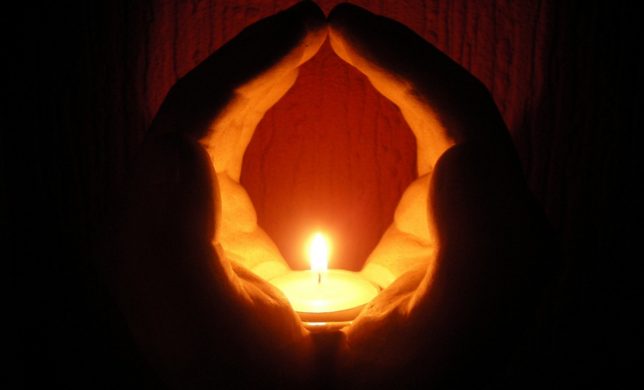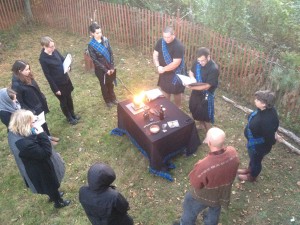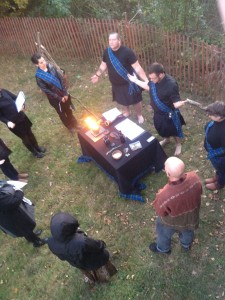We are happy to share this photo of our Community Outreach Coordinator, Daniel Negus, receiving a certificate of participation for Interfaith Harmony Week.

Awesome work, Dan!
See you all next year!
Blog
We are happy to share this photo of our Community Outreach Coordinator, Daniel Negus, receiving a certificate of participation for Interfaith Harmony Week.

Awesome work, Dan!
See you all next year!
“Now is the time of stirring, when the earth begins to soften and the waters to flow. While frost still bites and winds blow, and the light is growing stronger, and life begins to wake.“

“Imbolc is the day that we celebrate the passing of Winter and make way for Spring. It is the day we honour the rebirth of the Sun. It is also a day of celebrating the Celtic Goddess Brigid. [...] This is a time for communing with her, and tending the light of her sacred flame. At this time of year, we will light multiple candles or lanterns to remind us of the passing of Winter and the entrance into Spring, the time of the Sun.“
This past weekend, we joined the Pagan Presence Committee in the celebration of Imbolc as part of the 2017 Interfaith Harmony Week, a week which sees groups of multiple and diverse religions, faiths, and spiritualities open their doors to the public, inviting anyone interested in learning about and experiencing various traditions.
The evening opened with our Grove hosting a ritual, and followed with a “meet & greet”, where attendees got to explore a number of pagan tables and ask questions about the different paths and denominations. Snacks (including a chocolate fountain!! —yes, too exciting not to mention) were shared, and wonderful conversations were had. It was a lovely event, and we were pleased to be a part of it.
Happy Imbolc, everyone! <3
(All quotes are excerpts from the evening’s ritual, and photocred goes to Karen.)
We are happy to announce that we will be conducting our 2017 Imbolc ritual as a part of Halifax’s World Interfaith Harmony Week, in conjunction with the Earth Spirit Society of Nova Scotia (ESSNS), on Saturday, February 4th.

The ritual will take place in south end Halifax, at the Universalist Unitarian Church (5500 Inglis Street), and will be followed by a “meet & greet” where various pagan organizations in the city will have displays and information about their traditions
Doors open at 6:30pm, and the ritual (with an opening welcome statement and introduction) will begin promptly at 7:00pm.
Thanks to the hard work of the Pagan Presence Committee and ESSNS, the Pagan community has had an increasing involvement with interfaith in Halifax, and the Grove of Nova Scotia Druids is happy to be a part of it again this year.
For more information about Interfaith Harmony Halifax, visit: http://ihhalifax.ca/home/
For copy of the 2017 event guide, including all the events put on by different faith groups click here.

“Back at the time of Samhain, the Green Man, old and tired and naked of leaf and vine, bundled himself against the impending long, cold, dark nights and welcomed a deep and well-deserved rest. While he settled to sleep, we cast into the universe our hopes, dreams, desires, and wishes for the new year, before we too pulled our blankets up and waited for the days to once again grow long.
The night of Yule, the Winter Solstice, brings with it the rising of a new sun and the rebirth of the Green Man. We have made it through the darkest time of the year, the longest night, and we rejoice. Through the burning of the Yule log, we invite the light back into our homes, and we celebrate the knowledge that with all endings come new beginnings.”
Last night, we were finally able to get together for the celebration of Yule. There was singing and laughing and the sharing of bowls of homemade chili and cornbread and too many butter-tarts.
And also cat cuddles. (Because sometimes stereotypes are real.)
As spoken in ritual,
“let us take a moment to reflect on the love and respect we share for ourselves, each other, and this family. Let us continue to be present in each others’ lives, and to support one another through whatever challenges we each may face. […] Let us laugh and share, and be grateful for this life and this day, this fire and this food, these precious young souls, our homes, our jobs, our abilities to breathe, to speak, to listen, and to love.”
Happy Yule from all of us here in the GNSD!
-xo
The apple is the symbol of the Fruit Harvest. It is the symbol of life and immortality, of healing, renewal, regeneration, and wholeness. It is associated with beauty, longevity, and restored youth. In the Ogham, “Apple”, or “Queirt”, represents health and vitality. It is the heart of the Ogham Grove and the source of life.
The apple also holds a pagan secret: when cut width-wise, it will reveal a pentacle.
This afternoon, the Grove gathered together to celebrate Mabon, or Alban Elfed, the second harvest of the season. There was paint, snacks (coffee!), good weather, and gratitude. There was catching up, joking around, missing, sharing, laughing, and loving. Most importantly, there was friendship and there was family, and for these we are the most thankful.
A very happy [early] Mabon to you all!
-xo
Today I rose before the dawn.
I went outside to greet the sun, on this, the longest day of the year.
It was supposed to be a simple act of catharsis, though an important one – for a druid whose last full ritual was Beltaine, and who hasn’t prayed or meditated in what felt like months.
“Life got in the way”
“things are just too hectic from the move”
“I’ll start my daily devotionals again tomorrow”
As I sat there in quiet reflection, waiting for the sun to emerge from the rosy glow in the sky, a voice in the back of my mind kept whispering to me, “You’re missing something.” Eventually, the feeling got so strong I got up and brought my whole tote of ritual & altar gear outside onto the deck with me and set up a full impromptu ritual. This is what I love about ADF’s Core Order of Ritual – it was like riding a bike… by continued practice, the mundane-seeming physical actions of our rituals become second nature, and in those moments when our hands are busy and our minds are free, we can focus on the sacred significance that flows through, around, and between.
After the praises had been sung, and the offerings given, I was blessed with very good omens:
My omen of Acceptance of the Offerings Given was Muin (Vine) - a sign to, “Trust in what you have done and unwind”
My omen of Blessing (what the Gods grant in return) was Beith (Birch) – the tree of beginnings – which I took to be a glad sign of the gods’ invitation to a fresh start to my daily practice.
The ritual (and my morning) was comfortable and relaxed. I got up to greet the sun, and I felt like the light of the solstice soothed me in return. So when life gets busy, and you feel like you have no time for a regular spiritual practice, remember that making those few minutes of quiet reflection a priority can bring perspective and help you to better deal with the hectic flow of everyday life. Though not a pagan, I think Sukhraj S. Dhillon said it best:
“You should sit in meditation for twenty minutes everyday – unless you’re too busy; then you should sit for an hour.”
Today I rose before the dawn, to greet the sun
and it was glorious.
This year’s Beltane ritual was my first experience at holding the lead position in a major ritual. Not being accustomed to speaking in front of people, I was fairly nervous going into it, but also looked forward to the experience and the chance to face my fears and the challenge head on. Doing my due diligence, I researched the gods and goddesses associated with this festival, settling on the Welsh goddess Creiddylad and the Irish god Belanus. These deities both seemed to call to me. Belanus being the more obviously associated, being the namesake of Beltane — Bel (Belanus) and tane meaning fire — but also Creddylad, being the goddess of flowers and love and the daughter of the sea god Lir. These two gods seemed to balance and compliment one another like the best relationships seem to do, and being a traditional festival in which to hold marriage ceremonies, this seemed appropriate.

The ritual was going as well as could be expected, given that it was a cold and cloudy day. The rain held off, which was a god sent (pun intended). It was even a bit inspiring seeing the mist of my own breath escaping my lips. Images of the mists of Avalon jumped to mind briefly. Thankfully, I was able to project my lines for all to be able to hear, as that was a concern for me, being a quiet spoken individual by nature.
When the first Ogam was drawn —Blackthorn (“Wounding”) for the Omen— we were all a bit thrown. Were the gods displeased? We didn’t forget any of the offerings. We didn’t skip over anything vital. Why were the gods showing their displeasure at our gifts? So, adding a couple of more offerings to the fire, we drew another Ogam. This time, Yew (“Transition”) was drawn. A little better (and upon later reflection, explaining much). We were all relieved when, in return, the gods blessed us with the Ogam of Apple (“Wholeness”).
I must admit, I was rather thrown in the moment by what had been drawn. I even shed a few tears, but recovered enough to enjoy the maypole dance and other festivities, and then to close the ritual properly. Over the next couple of days, I reflected on the Ogams that we drew, and read over their meanings in greater depth. Blackthorn, although quickly translated to “Wounding”, also “offers initiation into the mysteries of self-conquest and transcendence”. Yew’s main translation, “Transition”, is also known for “transformation, renewal, (and) rebirth. An opening, a new element approaching.” Looking further into Apple was interesting as well. Not only was it’s basic meaning “Wholeness”, a very good blessing indeed to receive from the gods, but also a deep connection to the universe. While reading the section on Apple, a few more unexpected connections popped up. “The apple tree in Celtic myth is associated with Avalon, the Island of Apples,” where King Arthur is said to have gone to heal from “grievous wounds”. Belanus, the festival of Beltane, and the Son of Lir were all also mentioned within Apple’s explanation. The interconnections at play were numerous. Since thoughts of the mists of Avalon had come to mind due to the chill in the air and seeing my breath at the very start of the ritual, it being mentioned in the Apple’s texts was fascinating. For a connection to then appear for both of the deities that I had chosen to call upon, Beltane directly and Creiddylad, daughter of the sea god Lir (and therefore sister of the son of Lir), well, I must say, it felt as if the gods were definitely working their magic.
So, looking at the Ogams drawn for the Omens and Blessings received from the gods, I think that their combined meanings tells a larger story. We may all be wounded in many ways (Blackthorn, wounding), but it is through the healing (Yew, transition) of those wounds that we can become whole again (Apple, wholeness). It’s the point of the human experience really. The greatest lessons in life are often the result of the healing process from traumatic life experiences. This time of year, when the flowers spring forth from the ground and love is in the air, this is a time for transformation and rebirth. A reminder to let go of old wounds and to transition into wholeness. To learn from our experiences and become wholly who we are meant to become, both individually and as a grove.
So say we all.
-Written by Lily M.
(Quotes all taken from Ogam: the Celtic Oracle of the Trees by Paul Rhys Mountfort.)
**photocred: Karen
Save
Save
A few weekends ago, we came together and shouted a big welcome to the longer days, warmer weather, budding blossoms, and beginnings of new life.
Our Grove has recently welcomed some new members, including a tiny [and ridiculously adorable] addition (keep scrolling), and we are collectively delighted and blessed to see our little gatherings and festivities swiftly evolving into family celebrations.
We hope you all had a lovely Ostara (or Easter, or sunny spring day), and we wish you many new and exciting beginnings!
-xo
You can check out our Ostara posts from last year here and here.
From our Grove and family to you and yours, may we extend a very “Happy [belated] Yule“, “Merry Christmas“, “Happy Holidays“, and all the rest!
We are all oh so fortunate to find ourselves surrounded by amazing and inspiring people. On this day of celebration, we have feasted, exchanged gifts, laughed, and loved. To each other and to you we say thank you for being. May your days be eternally filled with love and warmth, and possibly an overload of cookies.
:)
Our Samhain celebration was a wonderful gathering, with a few new faces joining in our Grove’s celebration. we had 10 people in attendance for the ritual, with additional family and friends joining us for the feasting and celebration through the night. After opening the gates and calling to the Morrighan (who was the patroness of the rite), we had an ancestor meditation to honour those who had come before us. As is our grove tradition for this festival, we left the ritual space with the gates and invitation to the kindreds open, and proceeded inside for an amazing potluck supper – setting aside a plate at the ancestor altar for our honoured dead. Once all the desserts had been “sacrificed at the altar of our appetites” and the night was winding down, we went back out to our altar space to close the gates and thank the kindreds for their presence and the blessings bestowed.


The feast of Samhain comes from the ancient Celts, meaning “summer’s end.” This day is a holy in-between time, that sits opposite Beltaine in the wheel of the year. This is a time when we perceive the veil between this world and the next to be at it’s thinnest, and we might glimpse beyond to the otherworld.
Whereas Beltaine is a celebration of new life and vibrant fertility, Samhain is a celebration of our ancestors and those who have passed beyond this world. It celebrates and venerates the year and the lives that have ended, so that the cycle can begin anew. This is our “Pagan New Year”, for the ancients observed their calendar as beginning in the dark half of the year, much like our lives – which are begun in the darkness of the womb. It also marks a time of feasting and a celebration of the final harvest, so that the tribe could put on that needed layer of fat in preparation of the cold winter months ahead.
The meditation in our ritual was inspired by the Ancestor Prayer written by Rev. Michael Dangler from Three Cranes Grove, ADF,